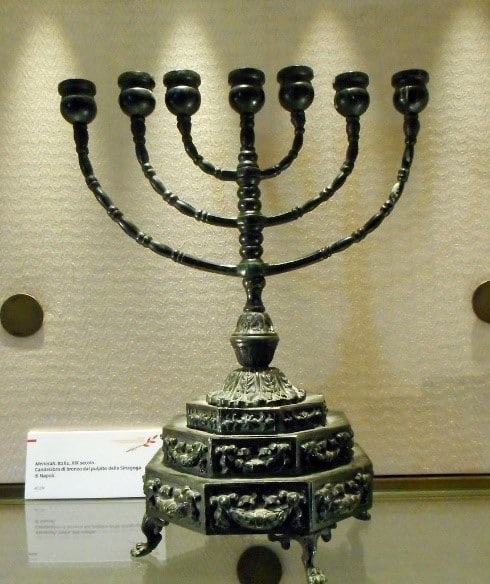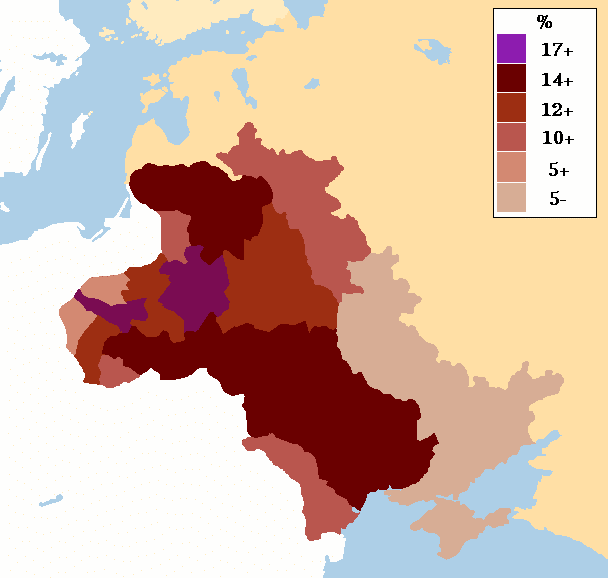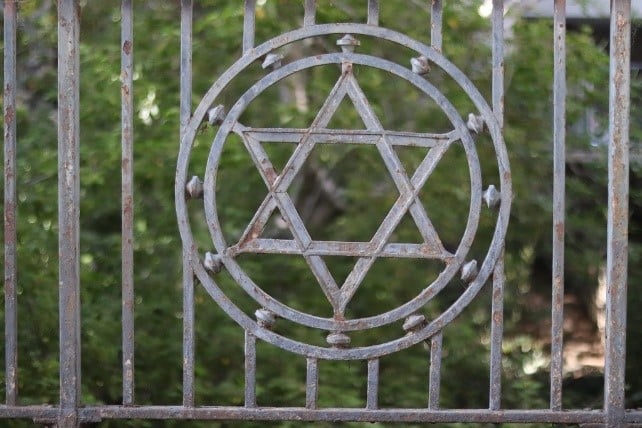Jewish Migration
 8
8Dec
December is the holiday season for multiple religions. This time of year, Christians celebrate Christmas and Jews celebrate Hanukkah. Those with Jewish heritage may also wish to celebrate Hanukkah by learning about their ancestors.
Jewish migration history
Over thousands of years, Jewish people have had a vibrant and diverse history in many lands. However, they also have also faced many persecutions and have been driven out of their homes. This has led to numerous migrations across Europe and around the world. The places where Jews lived in Europe often depended on which countries or regions where they were legally allowed to dwell.
A portion of the Russia Empire where Jews were allowed to reside is known as the Pale of Settlement. This was in the western region of the Russian empire and existed from 1791 to 1917. The map below shows the Pale of Settlement by portion of the Jewish population.[1]

Permanent residency by Jews was allowed within the Pale but was usually forbidden outside it. Even some cities within the pale forbade Jews to reside therein. Few Jews were allowed to live outside the Pale. Those with that privilege usually included those with a university education, the ennobled, [2]members of the most affluent merchant guilds and particular artisans, and some military personnel. Their families and sometimes their servants could live with them.[3]
 Life in the Pale was economically difficult. Many Jews were artisans and merchants, more than the overall population within the Pale needed.[4] This resulted in emigration out of the Pale. Emigration peaked in the late nineteenth century due to increased difficulties.
Life in the Pale was economically difficult. Many Jews were artisans and merchants, more than the overall population within the Pale needed.[4] This resulted in emigration out of the Pale. Emigration peaked in the late nineteenth century due to increased difficulties.
Under the rule of Tsar Nicholas I (1825-1855), the Pale of Settlement gradually shrank, with provinces being removed and Jews in certain areas being severely restricted. The next Tsar, Alexander II, expanded the rights of wealthy and educated Jews to leave the Pale. Things were looking better for the Jewish people until Tsar Alexander II was assassinated in 1881, and Jews were blamed. Anti-Jewish sentiment increased, and pogroms made life even more difficult for the Jews. Laws that were supposed to be temporary, banned new Jewish settlements outside the Pale, gave non-Jewish peasants the right to expel Jews from their towns, and allowed attacks against Jewish communities. All this, combined with poverty, was a push factor for Jews to leave.
One family’s migration to America
Three generations of the Levenson family left Odessa, Russia, in the early 1890s for Chicago, Cook, Illinois, USA, going through Montreal, Canada.
John Charles Levenson, of the youngest generation to emigrate, filed his Declaration of Intention in 1909 and his Petition for Naturalization in 1916 to be an American citizen. In his naturalization papers, he indicated that he previously resided in Odesa, Russia (now in Ukraine). He departed from Montreal, Canada, on or about 5 August 1893, traveled the Canadian Pacific Railroad, and arrived at Detroit, Michigan, on or about 7 August 1893. He had resided continually in Illinois since 7 August 1893, which suggests he went straight from Detroit, Michigan, to Illinois upon arrival. He renounced his allegiance to Nicholas II, Emperor of Russia.[5]
Since Montreal is a port city in Canada, it can be assumed that they traveled by ship from Europe to Montreal. Online databases of passengers arriving in Montreal have been searched to no avail. Non-indexed passenger lists have yet to be browsed.
[6] Border crossing records from Canada into the U.S. were kept beginning in 1895, two years after the Levensons arrived. The Levensons were searched for on the 1891 Canadian census but were not found. This suggests that they were not yet in Canada. It is unknown if they immediately took the train to the U.S. upon arrival or if they lingered in Montreal for a time.
Border crossing records from Canada into the U.S. were kept beginning in 1895, two years after the Levensons arrived. The Levensons were searched for on the 1891 Canadian census but were not found. This suggests that they were not yet in Canada. It is unknown if they immediately took the train to the U.S. upon arrival or if they lingered in Montreal for a time.
The Levensons were evidently part of a Jewish community upon arrival in the U.S. Jenny Levenson, John Charles’ wife, died on 7 April 1945 in Chicago, Cook, Illinois, at the age of sixty-seven.[7] The address listed on her death certificate is presently near a Jewish school and a Jewish congregation.
John Charles married Jennie Rosenberg, another Russian immigrant, after arriving in the U.S. John’s sister, Dora, also married a Jew. John Charles’ and Dora’s parents were Samuel Levenson and Sarah Chusid. Samuel’s parents were Charles Levenson and Laurcs Schmeadelson. They all migrated from Russia to the U.S. It is assumed that they migrated together, though only records for John Charles Levenson have been found so far. No siblings have yet been identified for Samuel. If his parents had more than one child, they also likely crossed the ocean.
More research is needed on this family to learn details of their story.
Resources for Research
Like any American research, census and vital records are a good starting place for Jewish American research. Just like with any other immigration research, naturalization records, and passenger lists are helpful for jumping the pond.
There are also resources specifically for Jewish research. JewishGen is one company that specializes in providing Jewish records of Jewish ancestors. Many of JewishGen’s records are on Ancestry due to the partnership between the two companies. JewishGen is also the best place to go for the following: [8]
- Family Tree of the Jewish People
- Memorial Plaques Indexing Project
- Discussion Group and Discussion Group Archives
- Family Finder
- Full-text translations Yizkor Boo Project
- KehilaLinks
- JewishGen Resource Map
- Gazetteer: 1.8 million+ locations in Europe, North Africa, & the Middle East
- Family Pages
Ancestry also has the following databases of Jewish ancestors:
- Europe, Registration of Foreigners and German Persecutees, 1939-1947
- Africa, Asia, & Europe, Passenger Lists of Displaced Persons 1946-1971
- Multiple Jewish newspaper databases
FamilySearch contains many records available for free. A search can be done in the Card Catalog for Jewish records. Additionally, unindexed records can be searched by going to Search> Images.
FindMyPast has the following Jewish resources:
- Kindertransport Records
- British Jewry Book of Honour 1914-1920
- Palestine Conflict British Deaths 1945-1948
- Greater London Marriage Index
- Manchester Naturalization Society 1896-1909
- Britain, Enemy Aliens and Internees, First and Second World Wars
MyHeritage, based in Israel, has partnerships with BillionGraves, the Israel Genealogy Research Association, Israel State Archives, JewishGen, and Litvak SIG. Some of their Jewish research collections include:
- Austria, Vienna Jewish Vital Records, 1835-1938
- Lithuanian Jewish Records from Litvak SIG 1795-1940
- Greece, Corfu & Sparta Vital Records, including Jews 1835-1935
- JDC Index of Jewish Displaced Person and Refugee Cards – Munich, Vienna, Barcelona, Hungary, and Warsaw
- Israel Genealogy Research Association Births, Marriages, Deaths
- Auschwitz Death Certificates, 1941-1943
GenealogyBank also has a link for Jewish research: https://www.genealogybank.com/static/ethnic/jewish-genealogy.html.
Celebrate Hanukkah this year by learning about your Jewish ancestors and their migration stories. Price Genealogy can help you discover your unique part of this history.
By Katie
[1] File:Map showing percentage of Jews in the Pale of Settlement and Congress Poland, c. 1905.Png. In Wikipedia. https://commons.wikimedia.org/wiki/File:Map_showing_percentage_of_Jews_in_the_Pale_of_Settlement_and_Congress_Poland,_c._1905.png
[2] Image is public domain.
[3] FamilySearch, FamilySearch Wiki, wiki (https://www.familysearch.org/en/wiki/Russia_Jewish_Records : 6 December 2023), Russia Jewish Records. ; Pale of Settlement. (2023, December 6). In Wikipedia. https://en.wikipedia.org/wiki/Pale_of_Settlement
[4] SOYER, D. (2018). Chapter 1: The Old World. In Jewish immigrant associations and American identity in New York, 1880-1939: Jewish ... “Landsmanshaftn” in American culture. essay, WAYNE State UNIV Press.
[5] Cook County, Illinois, Items no. 7172 & 20590, naturalization papers for John Charles Levenson, 1909 declaration of intention, 1916 petition and oath of allegiance, Circuit Court of Cook County, Chicago.
[6] Image is public domain.
[7] Illinois State of Illinois Department of Public Health--Division of Vital Statistics, death certificate 10242 (1945), Jennie Levenson; Public Board of Health Archives, Springfield, IL; images, FamilySearch. FamilySearch (https://familysearch.org : accessed 1 August 2023).
[8] Ellen Kowitt, “Jewish Resources on the Genealogy Giants,” video, uploaded 14 Jul 2021; Legacy Family Tree Webinars (https://familytreewebinars.com/webinar/comparing-jewish-resources-on-the-giant-genealogy-websites/?category=places&subcategory=jewish : accessed 5 December 2023).
